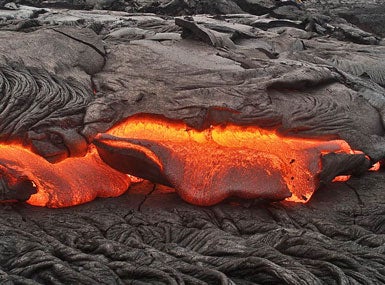Why don’t we just throw all our garbage into volcanoes?
Because it's a long way to the top if you want to rock and roll


Lava Splatter
Great question. Glad you asked. While volcanoes might seem like the ideal natural incinerator for our massive amounts of garbage, there are a few obstacles between us and a magical geological trash chute to the center of the earth.
Americans generate about 4 and a half pounds of trash per person, per day, or 254.1 million tons total per year. In order to dispose of all that trash in a volcano, you’d need to first locate an active volcano, and lug the trash there. That’s the first problem. Not many people live near active volcanoes, so transporting trash to a volcano would cost time, money, and a whole lot of fuel. Then there’s the fact that an even smaller number live near the right kind of active volcano.
That sounds like a volcanically snobby thing to say (oh, we don’t associate with those sorts of geological formations) but it’s the truth. When you picture throwing garbage into a volcano, you’re probably thinking of a nice, friendly cone shaped volcano with a hole at the top. Something like this:
And in the middle of the crater, you’re probably picturing a lovely lava lake that looks like this:
Perfect for throwing trash into, right? But not all volcanoes are cooperative like that. The ideal trash incinerator would be a slow-erupting volcano that gradually spews lava out onto the surface of the earth, like the volcanoes in Hawaii, called shield volcanoes. But the majority of volcanoes on Earth are stratovolcanoes which occasionally have lava flows like Kilauea, but also have the unfortunate tendency to explode when the pressure of hot gas and magma inside the volcano gets to be too much. Long story short, you don’t want to throw trash into an explosive volcano (think Mount St. Helens) when it’s erupting. If you’re close enough to throw trash into the exploding mass of molten rock, ash, and gases, you’re already dead.
But say you happen to live in Hawaii, close enough to haul your trash up to the summit of your friendly neighborhood active volcano every day. In addition to worrying about your house getting destroyed by lava, there’s also some danger to you (or a garbage truck) that’s dumping trash into a placid lake of lava. See, in addition to the poisonous gases and lava splatter which are already normal hazards at the summit of a volcano, when cold trash hits a large mass of lava, it can cause some spectacular explosions, as a group of researchers discovered in Ethiopia in 2002.

Awesome, right? But that was a 66-pound bag of trash, about three and a half days’ worth for a U.S. family of four. Imagine if that was a larger amount. Rockfalls into lava lakes in Hawaii have sent lava 280 feet into the air, splattering fences and scientific webcams with molten rock. That’s a little too much danger associated with taking out the trash.
Not to mention the fact that you’ll be burning a bunch of trash, and any smoke generated will go straight into the atmosphere, creating a lot of air pollution. Today, trash incinerators are governed by a web of regulations that make sure the smoke from burning trash doesn’t get into our air (they try to filter out major pollutants like ozone, carbon monoxide, sulfur dioxide, etc).
So throwing the mass detritus created by human civilization into a volcano isn’t an option. But what about more specialized waste, like medical or nuclear? Things that tend to be really dangerous? Unfortunately, volcanoes aren’t hot enough to melt nuclear fuel or sterilize medical waste. Temperatures of lava range from 1292 to 2282 degrees Fahrenheit, which is hot, but not hot enough.
It is, however, hot enough to devour a can of Chef Boyardee in a spectacular manner. Enjoy:
